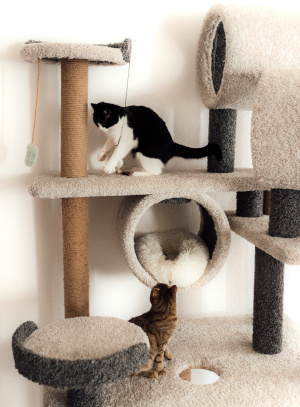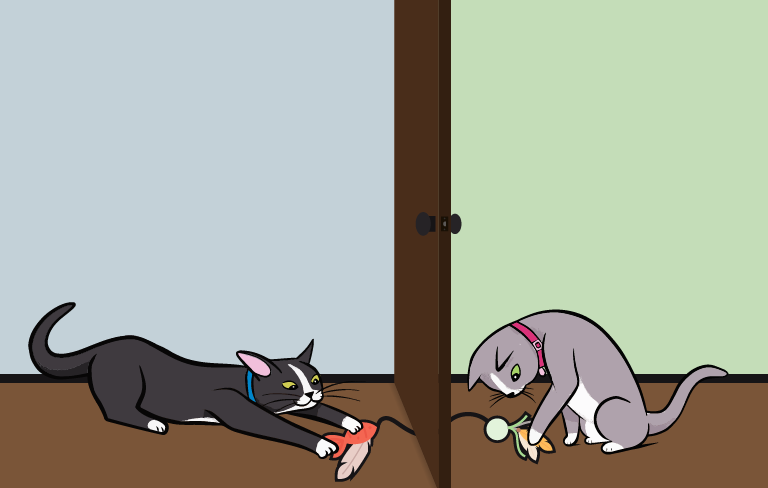
How well cats get along with each other is influenced by a range of factors related to the owner, the cats, the environment, and husbandry. In some situations, cats may learn to get along. In other cases, they may not be compatible. Patience is absolutely key; each cat is an individual and some may get on quickly, while others may take a long time to get used to sharing their home with another cat.
Firstly, it is important to carefully consider the needs of your existing cat or cats when thinking about adding a new feline family member. For example, do your current cat(s) have any health or behavioural concerns that might be negatively affected by the introduction of a new cat or that might make the successful integration of a new cat less likely? It is a good idea to discuss the potential introduction of a new cat with your veterinarian who knows your existing cat(s) and can help you consider what is in their best interests.
It is also important to assess if you will be able to meet the needs of all the cats including the new cat. There are five pillars of a healthy feline environment that need to be considered and optimised to help your cat(s) be as physically and mentally healthy as they can be:
- Provide a safe place
- Provide multiple and separated key environmental resources
- Provide opportunity for play and predatory behaviour
- Provide consistent and predictable human-cat social interaction
- Provide an environment that respects the importance of the cat’s sense of smell and other senses
You can find more information here about the five pillars and how to create a cat-friendly environment. There are special considerations involved for multi-cat households; you can find more information on that here.
If you do decide to add a new feline family member, make sure the cats are introduced in a way that maximises the chance of a successful and happy multi-cat home; but keep in mind that a harmonious multi-cat household is not guaranteed. The introduction of another cat can result in intercat tension which can negatively impact the wellbeing of all cats in the household.
Planning and preparation
The success of an introduction depends largely on careful planning and preparation.
- Socialisation – Preparation begins long before you bring a new cat home, with socialisation of your existing cat. Socialisation involves exposing animals to a range of experiences to help them prepare for and cope with different situations, interactions, and environments.
- Matching – When selecting your new cat, think about how well matched they will be for your existing cat.
- Health check – Make sure your cats have had recent health checks, and are up to date with their vaccinations, worming, and external parasite control, so they are in the best shape to cope with the introduction process and will not pose health risks to one another.
- Preparing the environment – providing your cats with an environment that meets all their needs is vital for cat wellbeing and to facilitate a successful multi-cat household. One key component to consider when preparing your home for a new cat is to make sure that there will be enough resources for all of the cats in your household. Each cat needs multiple and separated resources immediately available to them at all times (e.g., safe spaces such as elevated and hiding places, food, water, toileting areas, scratching areas, perches, play areas, and resting or sleeping areas). Note that the most common cause of intercat tension in a household is a lack of visually separated resources. See the RSPCA Guide to Keeping Your Cat Safe at and Happy at Home for more information.
- Cat containment – Keeping a cat contained on your property is especially important for new cats who are unfamiliar with the area.
- A transition room – Prepare a transition room where you can keep your new cat away from your existing cat(s). Make sure the space has everything they need (e.g., hiding places, a comfortable bed, toys, perches, scratching post, litter trays, food, water).
- Pheromone diffusers – Activating pheromone diffusers for 24-48hrs before bringing your new cat home and keeping them on during the introduction and integration process, may help your existing cat and the new arrival adjust. Out the diffusers in the main living area(s) and the transition room.
- Identity treats and positive experiences favoured by each of your existing cats and the new cat. These can then be used as high value rewards during training and the introduction process.
Bringing your new cat home
When you are bringing your new cat home, try to make this experience as stress free as possible. For some general information on bringing a new cat home see this Knowledgebase article.
Bring the new cat into their transition room in a covered carrier and make sure the new cat and existing cats do not see each other. Once your new cat is in their transition room and the room is secure, open the carrier door and just let the cat come out when they are comfortable. Once the cat has chosen to come out, just let them explore the room at their own pace and become familiar and comfortable with the new space.
Gradual introduction
To maximise the chance that unfamiliar cats will get along, introduce them gradually, step by step. Observe your cats’ behaviour to see if you should proceed to the next step. If any stage in the introduction process does not go well and/or any cat becomes distressed, it is vital to stop and go back at least one step and start again slowly from that point. Rushing the process or ignoring tension between the cats can result in long-term tension and negative welfare impacts.
Be prepared for the introduction process to take weeks to months.
Step 1: Scent introduction
Put items that have the new cat’s smell on them (such as bedding) into the existing cats’ space and let the cats investigate these at their own pace.
Put items that have the existing cats’ smell on them into the new cat’s transitional room and let the new cat investigate these at their own pace.
Step 2: Scent transfer
Once all the cats are comfortable with the smell of the other cats introduced during step one, you can start to transfer scents between the cats by rubbing a towel or cloth over your existing cat’s cheeks and chin and between their eyes and ears and leave the towel or cloth in your new cat’s transition room for the cat to investigate at their own pace. You can do the same with your new cat using a different towel or cloth and leave that in your existing cat’s area. Repeat daily until your cats are comfortable with each other’s scent/a communal scent.
Step 3: Interaction using play
If the cats are comfortable with the scent of the other cat, you can encourage them to play on either side of a closed door. This can be done by creating a double-sided toy (get two cat toys and tie them together with strong cord) that can be played with on either side of the door by both cats without them seeing one another. See below image that illustrates the concept.

The sessions should be kept short (less than 20 minutes) and ended before the cats lose interest in playing.
If there are any negative interactions between the cats during this process, stop the session and create some space between the cats to prevent them continuing the negative interactions on either side of the transition room door. You can use a screen, play pen, chairs or something else to create a space barrier in front of the transition room door.
Wait until the cats are calm before trying the play interaction again. Waiting until at least the next day is prudent.
Step 4: Allow independent but supervised exploration
Once all the cats are calm and comfortable with the preceding steps, you can progress to allowing the new cat to explore communal areas of the home without the existing cat(s) present. Settle the existing cat(s) in a room they like and secure them in there with the door closed. Then let the new cat explore the rest of the home at their own pace. After a short time, put the new cat back in their transition room and let the existing cat(s) out into the communal areas again.
Step 5: Supervised visual contact
Once all cats are relaxed and comfortable with the preceding steps you can allow short sessions of supervised visual contact between the new and existing cats while they are separated by a see-through barrier (e.g., glass door, child gate, or screen). If they are comfortable, gradually increase the duration of visual contact. If the cats seem at all uncomfortable, go back to step 4 for a few days and make sure all the cats are relaxed before trying step 5 again.
Step 6: Supervised sessions in controlled physical proximity
Once the cats are all comfortable and relaxed with seeing each other through the see-through barrier as in step 4 you can progress to allowing them to be in physical proximity but closely supervised and managed.
A good way to do this is to undertake sessions in the communal areas with each cat on a harness and leash held by a responsible adult and kept physically separate from the other cat. To do this will require that each cat has already been harness/leash trained gradually over time using reward-based training.
If the cats are not harness/leash trained, you can still take this step, but the cats still need to be kept separated and under close supervision and control – a responsible adult needs to be ready to stop the cats from getting too close and intervene with something that can safely block the cats’ view of each other and stop them coming into direct contact. Note that cats who are fearful, aroused, frustrated or stressed may redirect this onto a person or object, so it is important to make sure that an object that will keep the people intervening and the cats safe from injury (e.g., a large pillow, a towel or blanket or a big piece of strong cardboard) is used to block visual/physical access between the cats if necessary.
Even if using harnesses and leashes, a responsible adult needs to be ready to intervene as described above if the cats are showing signs of fear/anxiety/stress/frustration. Watch out for signs such as the cats flicking or lashing their tails, hissing, growling and intervene early – block the cats view of each other and use treats and/or objects to move the cats back into separate rooms and then go back to step 5 and don’t try to move onto step 6 again before the cats have calmed down and are relaxed again.
Use treats and play with each cat separately and physically separated but in the communal space together, this can help to both distract and reward the cats. Make sure that each cat can retreat of they want to and never force any interactions.
These sessions should be kept very short to begin with and ended while the cats are still calm and/or positively engaged with the rewards. If the sessions are going well, gradually increase the time in these sessions and then move on to the next step.
Step 7: Supervised free physical proximity
Once your cats seem comfortable with each other in supervised controlled sessions, you can progress to allowing the cats to have short, supervised sessions where they are not on a harness/leash and/or not being so carefully managed as in step 6.
Maintain separate resources, ensure they have their own areas to retreat to, and feed them separately.
As above, use treats and play with each cat separately and physically separated but in the communal space together.
It is still important to supervise them and be ready to intervene as in step 6 if the cats do start to show signs of fear/anxiety/stress/frustration.
Step 8: Unsupervised free physical proximity
Once your cats are comfortable with supervised free physical proximity, gradually increase the amount of time they spend together, and slowly phase out supervision.
Recognising and managing intercat conflict
It is important to be on the look out for signs of tension between your cats so that you can take action.
Stay alert to the following signs that can indicate intercat tension (note that the signs may be quite subtle):
- Staring (at the other cat or cats)
- Blocking (where one cat blocks access to a resource such as a litter tray or food, or may prevent a cat from escaping or moving freely, such as sitting in a hallway blocking the other cat from traversing it)
- Hiding
- Inhibition of normal behaviours (e.g., reduced appetite, sleep disturbances, inactivity, reduction in elimination behaviours such as not using the litter tray)
- Repelling behaviours (e.g., hissing, growling, striking, swatting, chasing)
- Displacement behaviours (where the stress the cat is experiencing is directed into an activity such as overgrooming)
- Marking behaviours (e.g., urine spraying, increasing scratching)
- Changes to toileting behaviours (e.g., inappropriate urination or defaecation).
A single or occasional incident of intercat tension may not be a problem but if persistent conflict occurs or there are serious consequences from the intercat tension (e.g., significant phsyical conflict, injuries, or concerning signs that may indicate a medical issue such as changes to toileting behaviours tray), seek advice from a vet or veterinary behaviourist. Separation, behaviour modification and, potentially, medications may be required at least in the short-term.
When you have more than one cat in your family, social acceptance between the cats is not guaranteed. When adding a new cat to a family with an existing cat or cats, the new cat must be viewed and treated as a separate social entity/group from the existing cats, at least initially, although that may change if the existing cats accept the new cat into their social group. For more information on multi-cat households and cat social groups see the RSPCA Guide to Keeping Your Cat Safe at and Happy at Home and for detailed information on intercat tension (including prevention and recognition and management) see the 2024 AAFP intercat tension guidelines.
Good husbandry
To maximise the chance that cats will thrive together in the same household, it is necessary to provide them with an environment that is optimised to meet the physical and mental needs of all of the cat, allows and encourages the expression of normal feline behaviours, minimises stress, and promotes good health and welfare. Providing each cat with multiple and separated resources (e.g., hiding places, elevated spaces, food, water, toileting areas, scratching areas, play areas and toys, and resting or sleeping areas) is critical. For more information on how to keep your cats happy and healthy, see the RSPCA Guide to Keeping Your Cat Safe at and Happy at Home.
References
Clark C (2016) Dealing with multi-cat households: management and treatment strategies. Companion Animal 21:68–74
Finka LR, Foreman-Worsley R (2022) Are multi-cat homes more stressful? A critical review of the evidence associated with cat group size and wellbeing. J Feline Med Surg 24:65–76
Horowitz D, Pike A (2016) Introducing a new cat into a household. Feline Behavioural Health and Welfare
Rodan I, Heath S (2016) Feline behavioral health and welfare. Elsevier, St. Louis, MO
Rodan I, Ramos D, Carney H, DePorter T, Horwitz DF, Mills D, Vitale K (2024) 2024 AAFP intercat tension guidelines: recognition, prevention and management. J Feline Med Surg 26: 1-30

